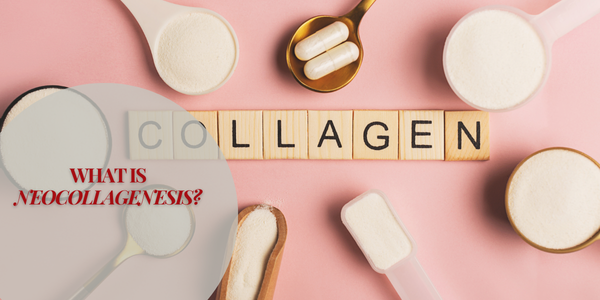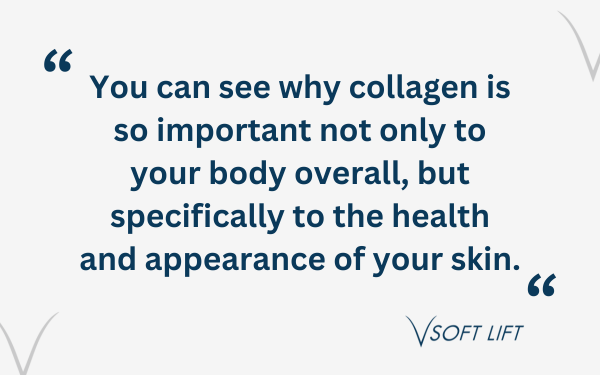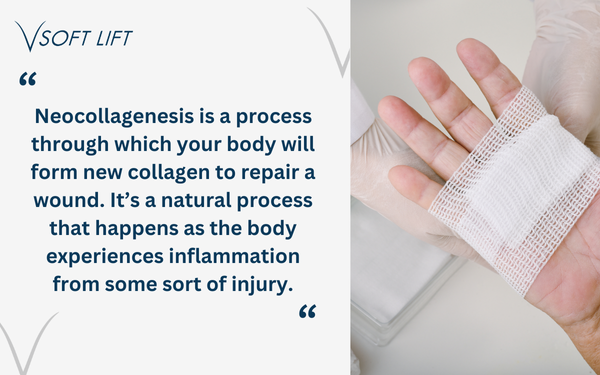
As we grow older, we grow wiser, but we also start to show the signs of aging. This commonly shows up in people in the form of wrinkles and fine lines, as well as saggy and drooping skin.
Unfortunately, most of these signs of aging begin to appear first in the most noticeable part of our body — our face. There’s nothing you can really do to prevent the aging process from happening, but there are things you can do to reverse the signs of aging, such as PDO thread treatments.
One of the reasons why PDO threads work so well as an anti-aging treatment is that they help the body produce more collagen, through a process called neocollagenesis.
Below, we’ll describe the importance of collagen in anti-aging treatments, and how PDO threads essentially stimulates neocollagenesis in the body.
Neocollagenesis is a process through which your body will form new collagen to repair a wound. It’s a natural process that happens as the body experiences inflammation from some sort of injury.
Table of Contents
Add a header to begin generating the table of contents
 Medically reviewed by: Elizabeth Williams RN
Medically reviewed by: Elizabeth Williams RN
Updated: 4/2/2025
What is Collagen?
Collagen is a protein1. In fact, it’s the body’s most abundant protein, accounting for roughly 30% of all the protein in your body2.
It serves as the primary building block for the skin, ligaments and tendons, muscles, bones and connective tissues. It can also be found in blood vessels, intestinal lining and organs3.
The main role of collagen is to provide different parts of your body with support, strength and structure. It plays a role in helping fibroblasts form in the dermis4 — or middle layer of your skin, helps replace dead skin cells, and also gives your skin strength, structure and elasticity.
You can see why collagen is so important not only to your body overall, but specifically to the health and appearance of your skin.

As you get older, though, the existing collagen that you have will break down quicker, and your body will also produce much less collagen than it did before5. This typically starts around the age of 30 and gets worse as we age6.
In fact, after women go through menopause, their bodies may see a significant reduction in how much collagen they produce7.
| Age | Collagen Level | Visible Effects | Recommended Treatments |
|---|---|---|---|
| 20s | Peak production | Firm, smooth skin | Preventive skincare, sunscreen |
| 30s | Begins to decline | Fine lines appear | Microneedling, light lasers |
| 40s | Noticeably reduced | Loss of elasticity, deeper wrinkles | PDO Threads, RF therapy |
| 50s+ | Severely diminished | Sagging, thinning skin | PDO Threads, collagen boosters |
What is Neocollagenesis?
Neocollagenesis is a process through which your body will form new collagen to repair a wound8. It’s a natural process that happens as the body experiences inflammation from some sort of injury.

Through neocollagenesis, you can experience significant anti-aging benefits. The extra collagen that’s produced in your face can help to smooth out wrinkles and fine lines. It can help to address sagging skin or a lack of contour and definition on parts of your face such as your lips and under eyelids.
Minimally-invasive anti-aging procedures have become extremely popular in recent years, and most of them use neocollagenesis in some fashion to achieve their results. This is true of PDO threads, too, which actually work to reverse the signs of aging in two different ways.
How Do PDO Threads Work for Anti-Aging?
There are many types of PDO threads, and each can be used to address different issues.
Some PDO threads have small barbs on the end of them that are used for lifting parts of the skin up. These mimic the results of a traditional facelift, as parts of your face will be physically lifted up and repositioned to add contour and address sagging skin.
For instance, if you want to fix sagging skin around your mouth that makes it look like you’re frowning at all times, your provider might use barbed PDO threads to lift part of the skin up into a more natural position.
All PDO threads, whether they have barbs or not, will also force the body to undergo neocollagenesis. That’s because any time a foreign object is inserted into your body — in this case, the thin synthetic PDO threads — your body will respond to the foreign object as if it’s an injury.
Once the PDO threads are inserted, your body will produce extra collagen in the area to help break down the threads naturally. The side benefit of this to patients is that they will see collagen produced in their face, which then helps to address some of the major signs of aging such as wrinkles and fine lines, and sagging skin.
V Soft Lift Produces High-Quality PDO Threads
PDO threads are so successful as an anti-aging treatment in large part because they force the body to undergo neocollagenesis, or the process of producing extra collagen. This is an important factor in anti-aging treatments, as our bodies will stop producing collagen as we age.
There are many things that PDO thread treatments can help you address. So, make sure to choose a provider who is well-respected and has experience with the treatments.
Also ensure that they are using the best PDO threads around, such as those produced by V Soft Lift.
We have created a long line of high-quality PDO threads, all of which initiate neocollagenesis in the body. Each of our different threads can be used for different types of treatments, on different parts of the body and for different skin types — all of which ensures you get the best results possible.
For more information, contact us today.
References
- https://my.clevelandclinic.org/health/articles/23089-collagen
- https://pmc.ncbi.nlm.nih.gov/articles/PMC3003457/#:~:text=Collagens%20are%20the%20most%20abundant%20proteins%20in%20mammals%20(%E2%88%BC30,molecular%20biology%20and%20gene%20cloning.
- https://www.medparkhospital.com/en-US/lifestyles/collagen
- https://pmc.ncbi.nlm.nih.gov/articles/PMC10217460/
- https://www.webmd.com/skin-problems-and-treatments/ss/slideshow-collagen-and-your-body
- https://us.revivecollagen.com/blogs/news/at-what-age-does-collagen-production-slow-down-and-when-you-can-start-taking-collagen-supplements#:~:text=Collagen%20production%20naturally%20begins%20to,they%20are%20in%20their%2030s.
- https://www.laurawyness.com/menopause-and-collagen-should-it-be-part-of-your-daily-routine#:~:text=This%20contributes%20to%20signs%20of,menopause%20(Thornton%2C%202013).
- https://pmc.ncbi.nlm.nih.gov/articles/PMC5064677/
